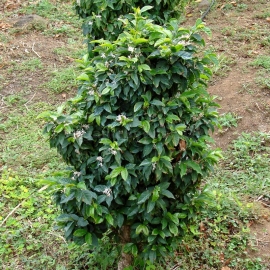 EXCLUSIVE
EXCLUSIVE



Coffee (Coffea Arabica) - Organic Seeds
2.00 €
As one of the world’s most popular commodities, it is grown commercially throughout South America. Commercial growth focuses on quick production and larger beans and so plants are placed in full sun and watered extensively.
-
Organic Coffee Seeds (Coffea Arabica)
Coffea Arabica is the variety whose beans are most commonly sold by coffee companies. Arabica has been cultivated in the Middle East since the sixth century, and evidence suggests that it was originally native to Ethiopia.
As one of the world’s most popular commodities, it is grown commercially throughout South America. Commercial growth focuses on quick production and larger beans and so plants are placed in full sun and watered extensively. Naturally, though, coffee grows in a semi-shaded area, which is said to produce a higher quality, although smaller bean. Growing your own coffee allows you to control this factor and potentially produce a higher quality, more organic coffee. Coffee makes an excellent houseplant that is relatively easy to grow and requires low maintenance once established.
Room temperature (65-70 degrees F) is ideal. It has attractive, dark green, glossy leaves. After two to three years, plants will begin blossoming white flowers and producing dark red cherries containing two beans each. Occasionally, berries will only contain a single bean, and these beans are said to have a distinct flavor.
Outdoors plants can reach ten to thirty feet in height if left untrimmed. Plants are capable of producing up to two pounds of coffee beans per year. Indoor plants will not grow nearly as large and can easily be controlled by pruning. New plants can be propagated by taking cuttings as you prune.
Growing Information
Sow your seeds about an inch below the surface of soil and keep it lightly moist. Too much moisture will cause the seeds to rot. Potting soil with some perlite added in for drainage will or it can be mixed with sand and compost. Germination can take a while, so you may choose to cover your planted seeds with clear plastic to keep in moisture. Otherwise, you will have to mist the soil when it is at risk of drying out completely.
Another option is sow your seeds in a sealable container or sandwich bag filled with either moist sand or the same soil mixture you will use to grow your plants. The advantage of using sand is that it is less likely to cause rot, but if your moisture level is correct that shouldn’t be a big concern. Check periodically to see when your seeds have sprouted. When you see a root popping out from the seed coat, plant the seed level with the soil in its own container with root facing down.
The advantages of this method is that it saves space while the seeds are waiting to germinate and it allows you to position the seed in the exact direction it should be growing. Be sure that the seed is not packed too tightly so that it can rise easily out of the soil as it grows. The seedling is still at risk of rotting until the seed coat is off, so be sure not to over water. The seed has is a papery outer layer and a hard shell underneath, which you may need to gently assist with the removal of if it is not coming off.
In warm climates, plants can be safely transplanted outdoors in a semi-shaded location after they are about 18?. Indoors, simply keep it near your window (preferably south, east or west). Feed the plants every two weeks from spring through fall and once a month during the winter with a 10-10-10 fertilizer. Allow the soil to dry out between waterings. Ideal humidity is around 50%, but is not essential.
